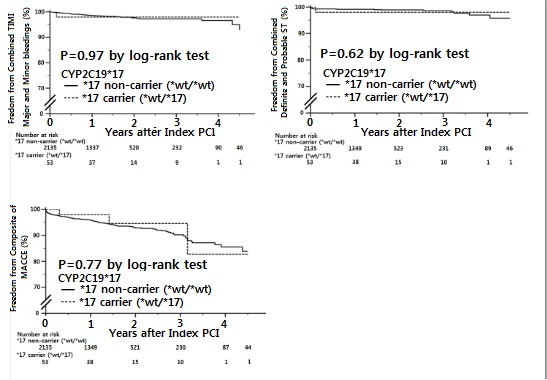| єя«•«ьљƒ : ±Єњђ
|
ЅҐЉцєш»£ - 550117 97 |
| Long-term Impact of Cytochrome 2C19*17 Polymorphism on Bleeding, Stent Thrombosis and Major Adverse Cardiac and Cerebrovascular Events in Korean PCI Patients on Treatment With Clopidogrel |
| к∞АнЖ®л¶≠ лМАнХЩкµР мЭШк≥ЉлМАнХЩ мИЬнЩШкЄ∞лВік≥Љ лМАм†ДмД±л™®л≥СмЫР¬є |
| л∞ХлІМмЫР¬є , мЮ•кЄ∞мЬ°, нЧИмД±нШЄ, мµЬлѓЉмДЭ, мЭімЮђл≤Ф, м°∞м†ХмД†, л∞Хм≤†мИШ, мЬ†кЄ∞лПЩ, кєАнЭђмЧі, кєАлПЩлєИ, кєАл≤Фм§А, мЭімҐЕлѓЉ, м†ДлСРмИШ, м†ХмЪ±мД±, мКєкЄ∞л∞∞ |
Background
The CYP2C19*17 variant allele has been associated with increased cytochrome P450 enzyme activity,which may cause an increased platelet response to clopidogrel. However,a pronounced interethnical variability is seen in the prevalence of *17 variant allele. The aim of this study was to assess the impact of CYP2C19*17 on long-term prognosis of Korean patients who were chronically treated with clopidogrel.
Results
This study included 2188 patients who received clopidogrel for at least 1 year after PCI. The median clopidogrel exposure time of the entire study population was 1.33 years (IQR 0.78-1.99). The longest follow-up measured in patients receiving clopidogrel was 6.95 years. The prevalence of *17 variant allele (*wt/*17: n=53 [2.4%], *17/*17: n=0) was very low compared with wild-type homozygotes (*wt/*wt: n=2133 [97.6%]). CYP2C19*17 carriage (*wt/*wt vs. *wt/*17) was not associated with an occurrence of a primary safety end point (combined TIMI major and minor bleedings: 1.9% vs. 1.8%, p=0.95, HR: 1.41, 95% CI: 0.19-10.4), or a primary efficacy end point (combined definite and probable stent thrombosis: 1.1% vs. 1.9%, p=0.6, HR: 1.02, 95% CI: 0.97-1.07), or a primary ischemic endpoint (composite of death from any cause, nonfatal myocardial infarction and stroke: 6.5% vs. 5.7%, p=0.89, HR: 1.21, 95% CI: 0.37-3.9) during clopidogrel exposure. In multivariate analysis, CYP2C19*17 carriage did not hold as an independent predictor for bleeding events (HR: 1.37, 95% CI: 0.18-10.1, p=0.75). We performed the 4.5-year event analyses with time-to-event data. Cumulative event-free survival for the prespecified primary endpoints using Kaplan-Meier analysis were not different according to CYP2C19*17 carrier status (Figure 1).
Conclusions
As the CYP2C19*17 allele is very rare and seems to have an insignificant role in the occurrence of adverse clinical outcomes in the Korean population, it might not be relevant to analyze the CYP2C19*17 allele in routine genotyping assays for clinical practice.
|
|
|
Warning: getimagesize(/home/virtual/circulationadmin/renewal/econgress/conference/abstract/img_files/duringexposurejpg.jpg) [function.getimagesize]: failed to open stream: No such file or directory in /home/virtual/circulationadmin/new/econgress/conference/manage/schedule/view_abstract.php on line 164

|
|





